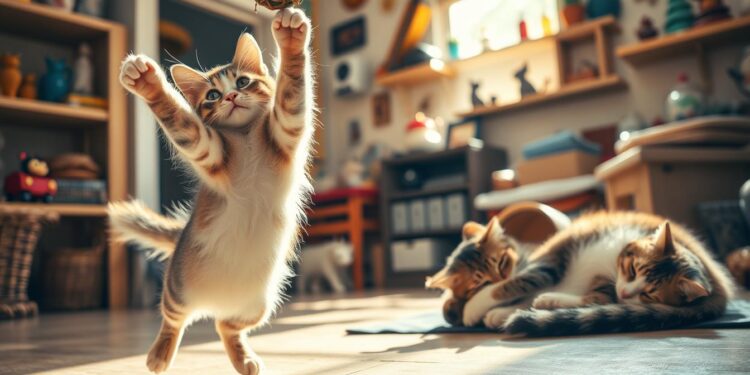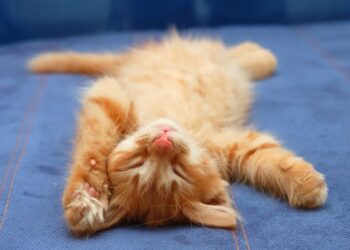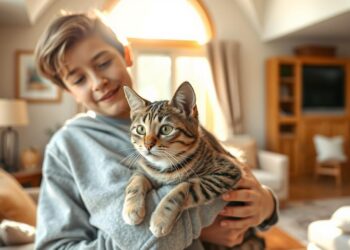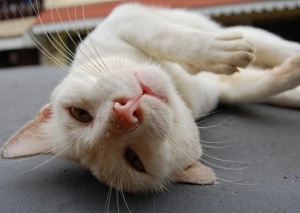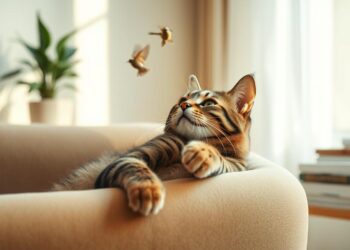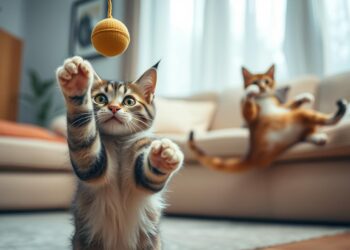Cats have a way of captivating our hearts with their quirky and sometimes unpredictable behaviors. Understanding these actions can be a challenge, but it’s crucial for building a strong bond with your feline friend.
By deciphering their complex system of communication, which includes vocalizations and body language, you can gain valuable insights into their needs and emotions. Recognizing their daily antics is essential for ensuring their physical and emotional wellbeing. In this guide, we’ll explore seven common behaviors that every cat owner should know.
From purring to unusual sleeping positions, understanding these behaviors will help you better connect with your cat and identify any potential health issues early on.
Understanding Your Cat’s Daily Behavior
Decoding your cat’s behavior can significantly enhance your bond with them. To truly understand your cat, it’s essential to consider their perspective and environment. People often approach cats with good intentions, only to be met with scratching or biting, leading to misunderstandings.
A cat’s behavior is heavily influenced by their surroundings. Factors such as available space, resources, other pets, and human interactions play crucial roles. It’s vital to assess whether a situation feels safe for the cat or might be causing them fear or anxiety.
Why Cats Behave the Way They Do
Cats have evolved as both predators and prey, significantly influencing their behavioral patterns. Understanding the evolutionary and biological basis of cat behavior provides crucial context for interpreting their daily actions. Behavioral changes in cats often indicate underlying health issues or environmental changes.
- Cats’ evolutionary history shapes their responses to various stimuli.
- Understanding the biological basis of cat behavior helps in interpreting their actions.
- Changes in behavior can signal health issues or stress.
The Importance of Reading Your Cat’s Body Language
Learning to read your cat’s body language is essential for anticipating their needs and avoiding negative interactions. Cat behavior is not just about actions; it’s also about postures and facial expressions. By understanding these cues, you can strengthen your bond with your cat and ensure a more harmonious coexistence.
Observing your cat’s daily behaviors and reactions can provide insights into their comfort and stress levels. This understanding can help you make informed decisions about their environment and interactions, ultimately enhancing their well-being.
The Secret Language of Cat Posture and Body Position
Observing a cat’s body position can provide valuable clues about its emotional state. Cats often use posture to communicate their comfort level and stress.
A cat’s posture is one of the most reliable indicators of their emotional state. Open postures generally signal comfort, while closed postures indicate stress or fear.
Open vs. Closed Postures: What They Mean
When cats feel threatened or scared, they tend to scrunch up into a small, less exposed shape. Conversely, when a cat stretches out, it shows that they don’t feel threatened. Understanding the difference between a cat feeling relaxed versus threatened can be observed through their body position.
| Posture Type | Emotional State |
|---|---|
| Open | Comfort, Relaxation |
| Closed | Stress, Fear |
The Belly Trap: Why Cats Show Their Bellies
Cats display their bellies as a sign of trust and relaxation. However, this exposed position also allows them to deploy all four sets of claws if they feel threatened. The infamous “belly trap” occurs when humans misinterpret a cat showing its belly as an invitation for belly rubs, when in reality, this posture can have multiple meanings depending on context.
In conclusion, understanding a cat’s posture and body language is crucial for interpreting their emotional state and responding appropriately. By recognizing the way a cat positions itself, owners can better understand their pet’s needs and feelings.
Daily Cat Behavior #1: Purring and Vocalizations
Purring and vocalizations are two primary ways cats express themselves, revealing their emotional state and needs. When a cat purrs, it is usually a sign of contentment and happiness. However, cats also sometimes purr when they are nervous or agitated. “Purring” is one of the most distinctive things about cats and can be extremely relaxing for humans.
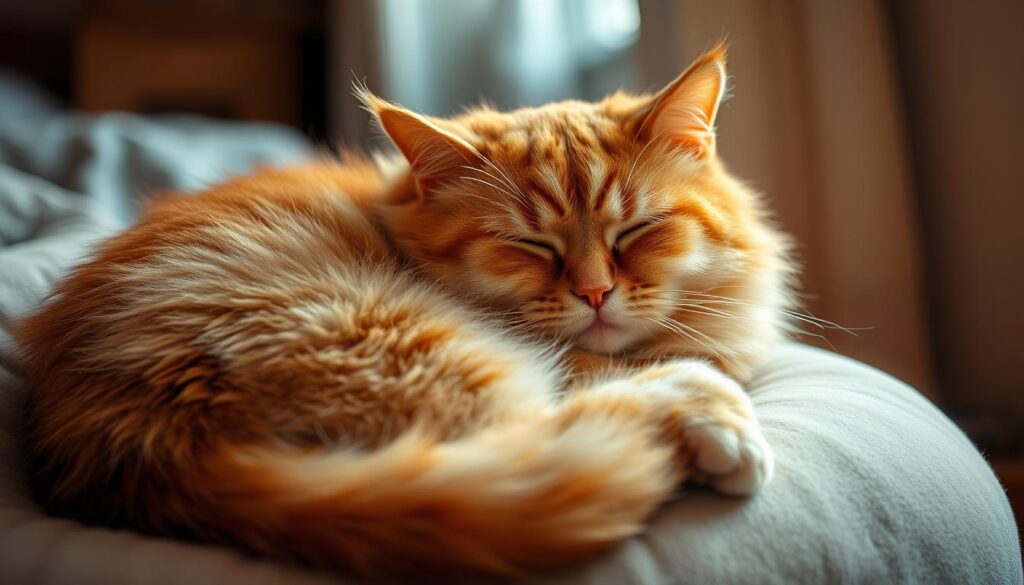
Different Types of Cat Sounds and Their Meanings
Cats have developed a sophisticated vocal communication system that includes various sounds beyond purring, such as meowing, chirping, trilling, chattering, hissing, and yowling. Meowing is particularly interesting as it’s primarily directed at humans rather than other cats, with adult cats rarely meowing to communicate with each other. The frequency, volume, and pattern of meowing can indicate different needs or emotional states, from simple greetings to urgent requests for attention or food.
When Meowing Might Signal a Problem
While meowing is a natural form of communication for cats, constant or unusual meowing patterns might signal health problems, anxiety, cognitive dysfunction in older cats, or environmental stressors that require attention. Understanding the nuances of your cat’s vocalizations helps strengthen your bond and allows you to respond appropriately to their needs and emotional states.
By paying attention to the context and variations in your cat’s vocalizations, you can better understand what they are trying to communicate, enhancing your relationship and ensuring their well-being.
Daily Cat Behavior #2: Kneading and “Making Biscuits”
One of the most charming and intriguing behaviors cats display is kneading, a natural action that involves pushing their paws against soft surfaces. This endearing behavior is a leftover from kittenhood, and understanding its origins can help cat owners appreciate their pet’s actions.
The Origins of Kneading Behavior
Kneading originates from the time when cats were kittens nursing from their mothers. The action of pressing on their mother’s stomach stimulates milk flow, a vital behavior for their survival. As adults, cats continue to knead when they feel relaxed and happy, often as a way to self-soothe or express contentment. This behavior is a sign of comfort and security, reminiscent of the nurturing they received as kittens.
How to Manage Kneading When Claws Are Involved
While kneading is a natural and generally harmless behavior, it can become problematic if your cat’s claws are extended, potentially causing discomfort or damage to furniture. To manage this, several strategies can be employed. Regular trimming of your cat’s claws can minimize the risk of injury or damage. Providing a dedicated surface for kneading, such as a thick blanket or a catnip-infused mat, can redirect the behavior away from undesirable targets. Using barriers, like a thick towel, between your skin and your cat’s claws during kneading can also help. It’s essential to never punish your cat for kneading, as this is a natural display of affection and comfort.
By understanding and managing kneading behavior, cat owners can strengthen their bond with their pets and ensure a comfortable and safe environment for both humans and cats alike.
Daily Cat Behavior #3: Rubbing and Head Bunting
The act of a cat rubbing its head and face on objects or people is a common yet intriguing behavior. This action, known as “bunting,” serves multiple purposes, including marking territory and showing affection.
When a cat rubs its face on an object, it releases facial pheromones. These chemical signals help cats recognize safe spaces and the people within their environment. The scent glands located on a cat’s cheeks, chin, forehead, and the base of its tail deposit these pheromones, creating a familiar and comforting environment filled with the cat’s own scent.
Territorial Marking vs. Showing Affection
Cats engage in rubbing behavior for dual purposes: territorial marking and showing affection. When cats rub against objects or people, they’re leaving their scent behind, which is a way of claiming their territory. This behavior also signifies a cat’s feeling of comfort and security in its environment.
- Cats have scent glands on their cheeks, chin, forehead, and base of the tail.
- Rubbing against surfaces deposits pheromones, marking territory.
- Head bunting is a significant sign of trust and affection.
How to Respond to Your Cat’s Rubbing Behavior
Understanding the difference between territory marking and affection requires observing other body language cues, such as purring, relaxed posture, and slow blinking. Responding appropriately to rubbing behavior by offering gentle pets and positive reinforcement strengthens your bond with your cat and encourages this natural way of communication.
By acknowledging and reciprocating your cat’s affectionate gestures, you foster a deeper connection and create a more harmonious living environment.
Daily Cat Behavior #4: Knocking Things Over
The behavior of cats knocking things over is a complex issue driven by multiple motivations, including curiosity, attention-seeking, and hunting instincts. Cats are naturally curious animals that use their paws to investigate objects, testing their movement and properties in ways that often result in items being pushed off edges.

Reasons Behind the Behavior
Many cats learn that knocking things over is an effective way to get immediate attention from their humans, even if that attention is negative. This behavior also satisfies hunting instincts, as the movement of objects falling mimics prey, providing mental stimulation and entertainment for indoor cats.
Protecting Your Belongings
For cat owners dealing with this frustrating behavior, understanding the underlying motivations is the first step toward effective management. Practical strategies to protect belongings include securing valuable things, providing alternative entertainment, scheduled play sessions, and using positive reinforcement to encourage appropriate behaviors.
By recognizing why cats engage in this behavior, cat owners can take steps to minimize the occurrence and protect their belongings.
Daily Cat Behavior #5: Scratching Furniture and Surfaces
Scratching is an inherent feline behavior that serves multiple purposes, from marking territory to maintaining claw health. Cats scratch furniture, carpets, and other surfaces for a variety of reasons: to remove the dead outer layer of their claws, to stretch their paws, or simply because it feels good!
The Natural Need Behind Scratching
Scratching is one of the most natural and necessary behaviors for cats, serving multiple important physical and psychological functions. This behavior helps cats maintain healthy claws by removing the dead outer sheath, stretch their bodies, mark territory through scent glands in their paws, and relieve stress or excitement. When cats scratch furniture and other household surfaces, they’re not being destructive out of spite but fulfilling these essential natural needs.
Understanding that scratching cannot and should not be eliminated is crucial; instead, cat owners should focus on redirecting this behavior to appropriate surfaces. To minimize damage to furniture, it’s essential to provide plenty of scratching surfaces. A quality cat tree is a great way to provide a multi-purpose space for your cat to observe, relax, play, and withdraw when they’re feeling overwhelmed.
Creating Cat-Friendly Scratching Alternatives
Creating cat-friendly scratching alternatives requires knowledge of your cat’s preferences for scratching position (horizontal vs. vertical), texture (carpet, sisal, cardboard, wood), and location. Effective solutions include strategically placed scratching posts, cat trees with integrated scratching surfaces, and cardboard scratchers.
| Scratching Surface | Texture Preference | Location Preference |
|---|---|---|
| Scratching Posts | Sisal, Carpet | Near Sleeping Areas |
| Cat Trees | Carpet, Sisal | High Traffic Areas |
| Cardboard Scratchers | Cardboard | Quiet, Private Areas |
By understanding and catering to your cat’s scratching needs, you can protect your furniture and ensure your cat remains happy and healthy. Providing the right scratching alternatives not only saves your belongings but also contributes to your cat’s overall well-being.
Daily Cat Behavior #6: Zoomies and Play Aggression
One of the most fascinating and entertaining aspects of cat behavior is their sudden bursts of energy, known as “zoomies.” These episodes are characterized by frantic running, jumping, and playful aggression, leaving many pet parents wondering about their causes and implications.
“Zoomies” are a normal expression of pent-up energy and hunting instincts in cats. These hyperactive episodes are more common in younger cats but can occur throughout a cat’s life, often following periods of rest or before regular feeding times.
Understanding Sudden Bursts of Energy
Sudden bursts of energy, or “zoomies,” are a natural behavior for many cats, especially kittens. This behavior is a manifestation of their innate hunting instincts and excess energy. Providing adequate exercise and daily enrichment can help limit these energy spurts.
- Engage your kitty with toys that simulate prey, such as feather wands or laser pointers.
- Utilize catnip and simple items like cardboard boxes to add variety to their environment.
Healthy Ways to Channel Your Cat’s Energy
Managing your cat’s energy in a healthy way requires a combination of environmental enrichment, interactive play sessions, and appropriate toys that simulate hunting experiences. Pet parents can create a cat-friendly environment by incorporating vertical spaces, puzzle feeders, and rotating toys.
By understanding the difference between play aggression and true aggression, pet parents can respond appropriately and avoid reinforcing problematic behaviors. Scheduled play sessions that mimic the hunt-catch-kill sequence can help channel your kitty’s energy in a positive way.
Daily Cat Behavior #7: Unusual Sleeping Positions
With cats spending around 16 hours a day asleep, their sleeping habits and positions are crucial indicators of their overall wellbeing. Cats adopt various sleeping positions, each revealing something unique about their comfort level, body temperature regulation, and sense of security in their environment.
What Your Cat’s Sleeping Position Reveals
The position in which your cat sleeps can be very telling. For instance, a cat sleeping in an exposed position with their belly up indicates complete trust and security, while a tightly curled position may suggest they’re conserving heat or feeling vulnerable. Understanding these positions can help you better understand your cat’s feeling of safety and relaxation.
Creating the Perfect Sleeping Environment for Your Cat
To ensure your cat gets the best sleep, it’s essential to create a conducive sleeping environment. This involves understanding your cat’s preferences for temperature, elevation, enclosure, and proximity to human activity. Moreover, the placement and design of the litter box play a significant role in your cat’s sleeping habits, as cats tend to avoid sleeping near soiled areas.
| Factor | Ideal Condition | Impact on Cat |
|---|---|---|
| Temperature | Warm and cozy | Affects comfort level |
| Litter Box Placement | Away from sleeping areas | Reduces stress |
| Elevation | High enough for security | Enhances sense of safety |
Following the rule of having one litter box per cat plus one extra, placed in quiet, accessible locations away from sleeping areas, can help ensure your cat feels secure enough to sleep deeply. By paying attention to these details, you can create a comfortable and stress-free environment for your cat to rest.
Conclusion: Strengthening Your Bond Through Understanding
Cats communicate in their own way, and understanding this language can deepen your bond with them. By recognizing and interpreting their behaviors, you can create a more nurturing environment that supports their physical and emotional needs.
The seven daily cat behaviors discussed in this guide provide a foundation for stronger communication and a deeper understanding of your feline companion. It’s essential to consider these behaviors as part of a single big picture, taking into account your cat’s individual personality, history, and environment.
Cat behavior is complex and nuanced, requiring patience and observation to interpret correctly. By respecting these natural behaviors, you can minimize problematic actions and create a harmonious household. Research shows that cats form genuine attachments to their human caregivers, and learning to “speak cat” can enhance this relationship.
To strengthen your bond, it’s crucial to understand why your cat behaves in certain ways. This knowledge transforms the human-cat relationship from one of coexistence to one of genuine communication and mutual understanding. Remember, each cat is an individual with unique preferences and personality traits that influence how they express common behaviors.
The effort invested in understanding your cat’s behavior will be rewarded with a stronger, more fulfilling bond and a harmonious household. By adopting this approach, you’ll be better equipped to provide appropriate care, enrichment, and interaction, leading to a more satisfying relationship with your feline companion.
